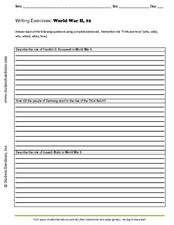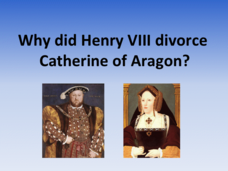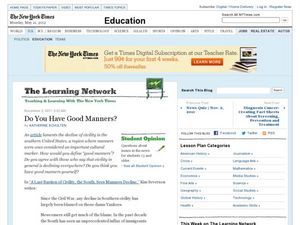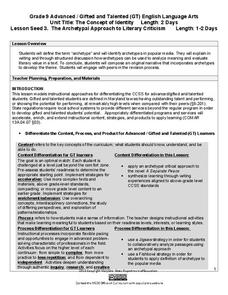Curated OER
Writing Exercise: Protestant Reformation I
Use this writing exercise to help learners develop an understanding of the Protestant Reformation. They answer two critical thinking questions related to the success and conditions that mad the reformation possible.
Curated OER
The Third Estate
Kids read a translated version of Abbe Sieyes' document, The Third Estate. This document is shown in its original form and as an English translation. After reading the text they answer three critical thinking question to show their...
Curated OER
Writing Exercise: French Revolution II
Get out that critical thinking cap and prepare to answer five thought-provoking questions. Each question on this worksheet pertains to the rise of the Monarchy during the French Revolution, the cause and effects of the Revolution, and...
Curated OER
Benito Juarez
Read and work to understand the words of Benito Juarez. An excerpt from the primary source document La Reforma is the focus of this worksheet. Learners will read the excerpt, then answer three critical thinking questions.
Curated OER
Imperialism: J.A. Hobson (1902)
J.A. Hobson was a popular writer, economist, and critic of Imperialism. Learners will read a short excerpt from one of his publications and answer two, two-part questions regarding his views on Western imperialism in Asia. Tip: Ask your...
Curated OER
Writing Exercises: World War II, #2
Comprehending the role of key players and events of WWII is a task all learners must undertake. Here, they respond to three critical thinking questions regarding the roles Roosevelt and Stalin played during the war as well as Germany's...
Curated OER
The Science of Thinking
How is fixing a flat tire like reading and writing? By thinking about each activity properly - identifying the problem and purpose, gathering information, and making inferences - you can exercise your thinking skills equally. This...
Curated OER
Why Did King Henry VIII Divorce Catherine of Aragon?
Why did King Henry divorce Catherine of Aragon, and how did he make divorce possible? Young historians will read through each informational slide to learn the story of Catherine of Aragon, King Henry, and Anne Boleyn. They will then...
Curated OER
Nov. 4, 2008 | Obama Is Elected President
Read this interesting background information regarding the presidential election of 2008. Your class will read the provided passages and then answer four critical thinking questions that require them to consider the reading and what they...
Curated OER
Nov. 2, 1976 | Carter Defeats Ford in Presidential Election
After reading about the presidential race in 1976, learners think critically about presidential legacy. They read all of the provided background information, related New York Times articles, and then respond to a writing prompt via blog...
Curated OER
Is It Ethical to Eat Meat?
Have your class join a blog about whether or not eating meat is good for you. They'll read several passages regarding meat processing and consumption, then they post what they think. There are six critical-thinking prompts to help them...
Curated OER
What Do You Think of Obama's Oval Office Speech on the Oil Spill?
Kids age 13 and older are asked to read the provided Times article and background information in order to construct a thoughtful blog response to Obama's first Oval Office speech. They work to address each of the related critical...
Curated OER
Do You Have Good Manners?
Who cares about manners anyway? According to the New York Times, Mrs. Mason does. Learners read and consider an article which addresses the decline of manners and the impact it has on society. They answer seven critical thinking...
Curated OER
Bias and Crime in Media
Critical thinking and social justice are central themes for this resource on bias and crime in media. The class views and discusses an incisive PSA that highlights assumptions based on race. Small groups read newspaper opinion pieces...
Curated OER
Crime Drama Teaching Units
Investigate the nature of crime dramas on television. What exactly are they trying to portray? Questions and a comparison chart support learners as they watch shows from Canada, Great Britain, and the United States. An oral presentation...
Curated OER
Favorite Sports and Athletes: an Introduction to Sports Media
Even young children watch sports and like team logos and products. It's never too early to think critically about what's onscreen. This exercise develops awareness that media communicate values (i.e. who participates in sports and who...
Media Smarts
Kellogg Special K Ads
Foster class discussion about body image with the resources and questions provided here. Focus on Special K's "look good on your own terms" ad campaign. Learners start by reading about this campaign and analyze a series of print ads,...
Curated OER
Political Cartoons: Literacy
Readers decode and deconstruct political cartoons to heighten critical thinking, extra-textual literacy, and making meaning from symbolism and metaphor. A compatible activity to use in English class when your 8th or 11th graders are...
Curated OER
The French Revolution and Napoleon, 1789-1815
Here is an interesting and somewhat interactive presentation. Covering the French Revolution, the slide show begins with a timeline of Napoleon's rise to power and ultimate fall. Main ideas for each event are then outlined with critical...
Curated OER
Sentence Completion 6: Low-Advanced SAT Level
Consider using this worksheet, another in a series of sentence completion exercises, as the basis of a lesson on test taking or comprehension strategies, as a critical thinking exercise, or as extra practice for up-coming standardized...
Curated OER
What's Missing Here? - Necessary Information
Take your third graders' problem-solving skills to the next level. Six word problems need a solution, but they aren't solvable in their current forms. Learners explain the piece of missing information that they need to solve the word...
Odyssey of the Mind
Odyssey of the Mind Curriculum Activity: Balance the Books
There is a difference between profit and revenue, and it's up to your class to find out why. They each research the public accounting documents for their favorite company or brand. Then they use their findings to discuss the differences...
Maryland Department of Education
The Concept of Identity Lesson 3: The Archetypal Approach to Literary Criticism
As class members continue their study of approaches to literary criticism, readers examine the symbolism and archetypal patterns in John Knowles' A Separate Peace, and how these parallels are used to develop a theme...
Curated OER
Critical Reading #1: "The Myth of Doomed Kids"
In this critical reading worksheet, students establish the context, author, and purpose of the piece then sum up the ideas that the author is trying to convey.
Other popular searches
- Reviews and Criticism
- United Nations Criticism
- Literary Criticism
- Accepting Criticism
- Constructive Criticism
- Feminist Criticism
- Types of Literary Criticism
- Canadian Artists Criticism
- Social Criticism
- Teaching Literary Criticism
- Dance Criticism
- Literary Criticism Beloved

























